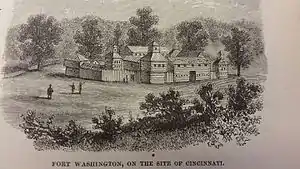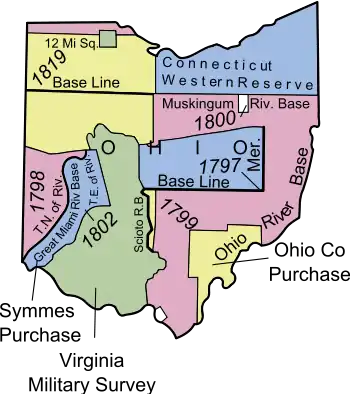Fort Washington (Ohio)
Fort Washington was a fortified stockade with blockhouses built by order of Gen. Josiah Harmar starting in summer 1789 in what is now downtown Cincinnati, Ohio near the Ohio River. The physical location of the fort was facing the mouth of the Licking River, above present day Fort Washington Way. The fort was named in honor of President George Washington. The Fort was the major staging place and conduit for settlers, troops and supplies during the settlement of the Northwest Territory.
| Fort Washington | |
|---|---|
| Part of the Northwest Territory of the United States | |
| Cincinnati, Ohio | |
 | |
| Coordinates | 39°5′58.24″N 84°30′26.59″W |
| Type | Army Fortress |
| Site history | |
| Built | 1789 |
| Demolished | 1806 |
| Battles/wars | Northwest Indian War |
| Garrison information | |
| Past commanders | Gen. Arthur St. Clair, Gen. Josiah Harmar, Gen. "Mad" Anthony Wayne, Gen. James Wilkinson |
| Occupants | United States Army |

In 1803, the fort was moved to Newport, KY across the river and became the Newport Barracks. In 1806, the site of the abandoned fort was divided into lots and sold.
History
Losantiville
When Judge John Cleves Symmes contracted with the Continental Congress to purchase 1,000,000 acres in southwestern Ohio known as the Symmes Purchase in 1788,[2] it reserved 15 acres to the federal government for a fort.[3] In summer 1789, Fort Washington was built to protect early settlements located in the Symmes Purchase area, including Losantiville, Columbia and Northbend.

Gen. Arthur St. Clair was appointed governor of the Northwest Territory by vote of Congress on October 5, 1787. When Governor St. Clair arrived at Losantiville [Cincinnati] the settlement consisted of two small hewed log houses and several cabins. Maj. John Doughty, under orders from Gen. Josiah Harmar, was engaged with a small military force in finishing the construction of Fort Washington. The population of the crude village, exclusive of the military, probably did not exceed one hundred and fifty.[4] Three days after Gen. Harmar took up his quarters at Fort Washington, on January 1, 1790, Governor St. Clair was received with due ceremony by the troops and citizens of Losantiville.
Fort Washington was distinguished by its large size: it was larger than a modern city block and designed to house up to 1500 men. Gen. Josiah Harmar described it as "one of the most solid substantial wooden fortresses. . .of any in the Western Territory." The stockade's walls were two stories high with blockhouses located at each corner. [5]
Indian campaigns
The fort was used as a staging point and to supply all the northern forts. It played a key supporting role in three Indian campaigns: Harmar's Campaign 1790, St. Clair's Campaign 1791, and Gen. "Mad" Anthony Wayne's campaign in 1793-94.
In 1790, Harmar used Fort Washington to launch an expedition against Native Americans in northwest Ohio, especially the Miami Indians, whose principal city was Kekionga (modern-day Fort Wayne, Indiana). On October 22, 1790, Gen. Harmar's army was ambushed and massacred by Indians led by Chief Little Turtle. The Indians of the Northwest Territory were in open revolt aided by the British. Indian raids came close to Cincinnati, despite the presence of the nearby Fort Washington.
In the spring of 1793, Major General Anthony Wayne moved his forces from the training center at Legionville, PA, down the Ohio River by barge to a camp outside Fort Washington that was called Hobson's Choice. In the fall, Wayne departed Fort Washington and moved his army northward, past Fort Jefferson, to build Fort Greene Ville.
Decline and sale
By 1802, Fort Washington had fallen into disuse and disrepair, and was manned by only half a company (about 35 men). In 1803 it was replaced by the larger Newport Barracks established to house the Kentucky Militia. It was opened just across the Ohio River in Newport, Kentucky. James Taylor Jr., an influential resident of Newport, Kentucky, had lobbied his cousin James Madison to place the post in Newport.
On February 28, 1806, Congress directed the Secretary of the Treasury to cause the site of the abandoned fort to be surveyed and laid off into lots, streets and avenues conforming to the plan of the city, and to sell the lots to the highest bidders at a sale at the Cincinnati Land Office.[6][7] The survey, certified July 8, 1807, shows the fort's boundaries to be Fourth Street to the north, Ludlow Street to the east, the Ohio River to the south, and Broadway to the west.[8]
Rediscovery
In October 1952, excavators discovered the remnants of Fort Washington's gunpowder magazine under the northeast corner of Broadway and Third streets, at the site at which Western & Southern Life Insurance Company's parking garage was to be constructed. Researchers with the Historical and Philosophical Society of Ohio first visited the site on October 13, 1952.[9][10]
The fort's name is retained in Fort Washington Way, a section of Interstate 71 and U.S. Route 50 that runs through downtown Cincinnati and passes just in front of the former fort. The highway was given this name in 1958 upon a suggestion from the Cincinnati Times-Star editorial board and with the support of the state's Anthony Wayne Parkway Board, the Cincinnati Enquirer editorial board, and Mrs. William T. Buckner, whose great-grandfather William Henry Harrison once served at the fort.[11][12][13]
The location is marked by a plaque at the Guilford School building, at 421 E 4th St, Cincinnati, which now occupies the site.
Notes
- Lossing, Benson (1868). The Pictorial Field-Book of the War of 1812. Harper & Brothers, Publishers. p. 41.
- When the patent was approved by President Washington in 1794, the area had been reduced to 311,682 acres
- Knepper 2002 : 32
- History Of Cincinnati And Hamilton County, Ohio
- Fort Washington – Ohio History Central – A product of the Ohio Historical Society
- Peters, William E. (1918). Ohio Lands and Their Subdivision. W.E. Peters. p. 282.
- 2 Stat. 352 – Text of Act of February 28, 1806 Library of Congress
- Knepper 2002 : 54
- Knopf, Richard C.; Baby, Raymond S.; Smith, Dwight L. (January 1953). "The Re-Discovery of Fort Washington" (PDF). Bulletin of the Historical and Philosophical Society of Ohio. Cincinnati, Ohio: Historical and Philosophical Society of Ohio. 11 (1): 3–12. Retrieved October 25, 2015.
- Baby, Raymond S.; Knopf, Richard C. "Additional Structural Features of the Fort Washington Powder Magazine" (PDF). Bulletin of the Historical and Philosophical Society of Ohio. 11 (4): 320–325. Retrieved October 25, 2015.
- "Three Roads, Three Heroes". Editorial. The Cincinnati Enquirer. Gannett Company. February 21, 1958. p. 4. Retrieved October 25, 2015 – via Newspapers.com.
- Kirkpatrick, Dick (February 15, 1958). "Board Urges Development Of Waterfront To Preserve Area's Historical Resources". The Cincinnati Enquirer. p. 1. Retrieved October 25, 2015 – via Newspapers.com.
- Sands, Gilbert (February 25, 1959). "Fort Washington Freeway Favored Name For Distributor". The Cincinnati Enquirer. p. 10 – via Newspapers.com.
References
- Knepper, George W (2002). The Official Ohio Lands Book (PDF). The Auditor of the State of Ohio.
- Jones, Robert Ralston (1902). Fort Washington at Cincinnati, Ohio. Cincinnati: Society of Colonial Wars in the State of Ohio.
